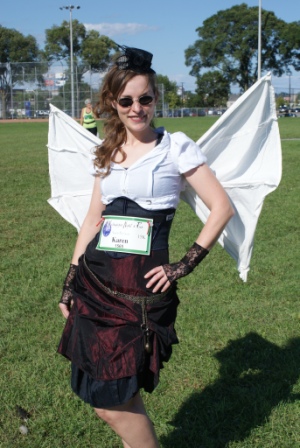The Importance of the Warm-Up
With the fall racing season now upon us, I thought I would re-send this article as a refresher for all to make sure to get in a good warm-up before your races and hard training sessions.
Have you ever wondered why people warm-up before a race? Why waste the energy? Why not save it for the race?
Quite simply, the warm-up gets the mind and body ready for the hard work ahead of it. Most bodies need to be gently coaxed out of their protective shell in order to push hard—blood flow to the various muscles needs to be increased so the muscle warms up and becomes a bit more flexible, which allows for easier movement and reduced chance of injury.
As for the mind, most people need some time to get psyched up for the discomfort level in the near future. The warm-routine helps with this aspect as well.
I’ve been running for a loonngg time, and morning runs are my favourite, but also my nemesis—without 20-30min of walking around and a cup of coffee, I start my runs like a 70 year old who’s never run before, and that’s not right. When I start my morning runs, I’m stiff and sore and slow for 20min and then, gradually, the blood starts to get through to deeper and deeper muscle tissue, and I loosen up. And speed up.
One of those muscles is, of course, the heart. Have you ever noticed you breathe really heavily at the start of your run and after a little while, things settle down? You’ve just warmed up.
I suggest every run you do start off at a gentle pace, then build to the pace you want to maintain. Using your breathing as a guide works very well for this. If you are breathing hard, you started too hard. Later in the run, it’s a different story. I’m talking about the first 10-15min.
The importance of a warm-up when racing has never been scientifically proven to be beneficial, but the mountain of anecdotal evidence is rather impressive, so I believe in it a great deal.
Further, I’ve always believed that to be good at whatever it is you want to be good at, you do what the other people who are good at it do, and when it comes to running, they all warm-up before workouts and races. Therefore, so do I.
Again, the idea of the warm-up is to get your body ready for race effort. Ideally, you want to get your body ready so it’s good to go on the start line, not a kilometer or two after the gun goes off.
With that in mind, I suggest the following as a good routine to follow for a 5 or 10k race. It should take 30min or so.
- Run for 10-15min building your intensity from ultra easy to just under threshold (race pace) for the final 2 minutes or so.
- Gently stretch, do running drills, some dynamic stretching and hydrate
- Washroom
- Change clothes into your racing attire
- Move out to the start line
- Continue with the dynamic stretching and running drills interspersed with 4-5 easy accelerations of between 80-100m. Start by running easily and gently get yourself up to race pace within the acceleration, hold for 5-10 sec. Run easily back to where you started from and repeat 4-5 times. These are not designed to get you tired, so take more rest if necessary, but be sure to keep moving.
- You should be ready to go.
At the beginning of this article, I asked two questions: Why waste the energy? Why not save it for the race?
Well, if you actually want to race the event, your energy supply to cover the distance should be the least of your worries. If it is, you will be surviving the event, not racing it.
One final note is that the importance of a warm-up is directly proportional to a few things:
- how hard you intend to push yourself—if you’re out for a social run, it’s not that important. If you’re out for a fast time, it is very important to be ready to go when the gun goes off.
- how long the race is—the longer the race, the shorter the warm-up because the intensity of the effort is not as high, and you can build into it in the early stages of the race. In a short race, you don’t have time to find your rhythm. You gotta have it from the start.
- the weather—considering the above, if it’s really hot, a warm-up is less necessary (but still necessary). If it’s really cold, it’s very necessary.
I hope this helps.



 Our Magazine
Our Magazine
